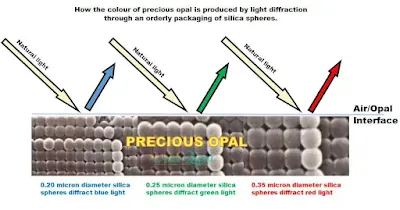How Does Opal Get Its Color
What causes the colors in opal? How does opal get its color? Where do opals get their colors? What is the structure of opals? Why does opal have color?
Opal hues can range across the spectrum. An opal might display a single color, two or three colors, or all the colors of the rainbow. Precious Opal - is opal which exhibits the phenomenon known as play of color, which is produced by the diffraction of white light through a micro-structure of orderly arrayed spheres of silica.The internal structure of precious opal makes it diffract light; depending on the conditions in which it formed, it can take on many colors.
The variety of natural opal is determined by the two characteristics of body tone and transparency.
- Body Tone - The base tones of light, dark and black opal range from colorless, white, through the various shades of grey, to black.
- Transparency - Opal of any body color will be opaque, translucent or transparent. When it is transparent or very translucent, and the color clarity is sharp, it is often referred to as crystal opal.
The Structure of Opals
Basically, opal is made up of water and silica (the main component in glass). A silica solution forms when silica from under the earth mixes with water. This solution fills voids or is trapped in layers under the earth, and opal begins to form.
Over a long period of time, the solution settles and the water evaporates, allowing the gradual formation of layer upon layer of microscopic silica spheres. The spheres are formed because particles of silica spontaneously adhere to other particles which form around it. These spheres of range in size from 1500 to 3500 angstroms (1 angstrom is 1 ten millionth of 1 millimetre).
 |
| Bragg angle adapted to the silica sphere structure of precious opal producing a play-of-color Photo: opalquest.com |
What causes the colors in opal
When white light waves enter the top of an opal, they refract and bounce around inside the opal, through all the microscopic spheres and the gaps between the spheres. As the light passes through the spheres and gaps, it diffracts (splits). Like a prism, the opal splits the white light into all the colors of the spectrum, and the light eventually bounces back out the top of the stone, at which point we get an eyeful of beautiful opal colors. The opal is the only known gemstone that is able to naturally diffract light in this way.
You may have noticed that some opals don't have all the colors of the spectrum. Many opals can only display blue coloring, for example. This is because the diameter and spacing of the spheres controls the color range of an opal. Getting back to our color diffraction theory, the size and angle at which light is split determines the color produced.
Small spheres produce opal of blue color only (the most common), whereas larger spheres produce red (the rarest color). When the spheres inside the opal are bigger (about 3500 angstroms diameter) the red or orange colors are produced. At the other end of the scale, at about 1500 angstroms in diameter, the blue end of the spectrum is diffracted. Between these sizes the rest of the colors of the rainbow occur.
Therefore the rarity of the colors (most common to least common) is as follows: blue, green, yellow, orange, and red. Opals which display red can also display all the other colors of the spectrum. Therefore the possible combinations of colors in an opal can be seen as: blue only, blue-green, blue-green-yellow, blue-green-yellow-orange, and finally the full spectrum of blue-green-yellow-orange-red.
For this reason, the presence of red in an opal can greatly add to its value, since it is somewhat of a rarity. Opals can also contain aqua and purple as well as the other 'non-primary' colors which are produced when two primary colors are combined. (For example, the green and orange between the primary colors of blue, yellow, and red).
Read also:
Types of Opal With Photos
Why Is Australian Opal Unique?
Harlequin Opal: The Rarest and Most Expensive Pattern of Opal

.webp)
%20(1).webp)






